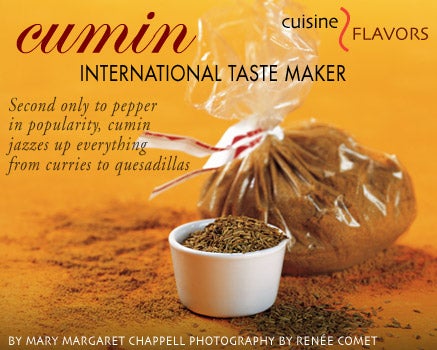Cumin: International Taste Maker

Cooks and cumin go way back—
something like 6,000 years. Use of
the spice was common throughout
the Mediterranean basin long before
spice routes brought more exotic
seasonings such as black pepper,
cinnamon and ginger into the area.
“Achilles and Helen of Troy,
if they ever existed, would have
known cumin’s flavor,” says Jack
Turner, author of Spice: The History
of a Temptation.
But cumin isn’t just one of the oldest
spices around; it’s also one of the most
widely used. Over the years, er,
millennia, this distinctive, pungent seed
spread beyond the Mediterranean
to India, Asia, Northern Europe,
Mexico and Latin America. “Still, many
people associate cumin mainly with
Eastern cuisine, and its popularity
in countries such as India is a reminder
that traffic along the spice routes
and the exchange of recipes went both
ways,” Turner adds.
Cumin has played such a big role
in India’s culinary heritage that it feels
like a native seasoning. “It’s very
important in Indian cooking,” says
Madhur Jaffrey, author of Madhur
Jaffrey’s World Vegetarian: More Than
650 Meatless Recipes from Around the
Globe. The strong, smoky taste is
an integral part of curries, vegetable
stews and chutneys. And no masala
dabba (a round stainless steel box
containing seven spices that Indian
cooks keep by the stove) would be
complete without both ground cumin
and whole seeds. Northern Indians
even cultivate their own variety of the
spice, black cumin, which has a
stronger, more complex flavor than
regular cumin.
But most North Americans know
cumin through Mexican cooking.
At Casa Tina, a Mexican restaurant
in Dunedin, FL, that specializes
in vegetarian dishes, chef/owner Javier
Avila uses cumin in 15 different sauces
and every batch of rice.
“A little cumin wakes up all the
flavors—even a small dash in
guacamole can make a big difference,”
he says. Avila is also a fan of pairing
cumin with tropical fruits. “My mother
used to roast whole seeds and then
sprinkle them over papayas with a little
lime and salt. And I love mangoes
sprinkled with ground cumin and
cayenne—there’s another example of
the endless ways you can use it.”
Although whole or ground cumin
can be used straight from the jar, most
chefs recommend toasting it 1 to 2
minutes in a dry nonstick skillet to
intensify the aroma and taste. Or just
fry the whole seeds in hot oil for a few
seconds—an Indian cooking technique
called tarka. One of Jaffrey’s favorite
recipes involves cooking cumin this
way, then adding potatoes. “All you
have to do is pop whole cumin
seeds into hot oil, then stir in boiled
potatoes,” she explains. “Children absolutely love it just like that, or you
can make it fancier by adding ginger
and tomatoes.”
Even if you’re not going the ethnic
route for dinner tonight, a dash of
ground cumin can do wonders for bean
dishes, eggs, hummus or even a can of
tomato soup. Cumin is also good with
legumes and leafy greens; it gives both
a rich, complex flavor that tames any
bitterness. Whole seeds add depth and
texture when stirred into soft cheeses,
sandwich spreads and salad dressings
or sprinkled on top of dinner rolls
before baking.
So take a cue from cooks around the
world and keep supplies of both the
whole and ground spice on hand. That
way, you, too, can carry on an age-old
culinary tradition just by sprinkling on
one or stirring in the other.
RECIPE
Potatoes Tarka (Potatoes with Cumin Seeds)
Serves 4 ● Vegan ● 30 minutes or fewer
This simple Indian cooking technique
transforms boiled potatoes. If the
cumin seeds cook too long and burn
(they will look black and lose their
fragrance), just start over with fresh oil
and seeds before adding the potatoes.
1 lb. new potatoes, quartered
2 Tbs. vegetable oil
1 Tbs. cumin seeds
1⁄2 tsp. salt
1⁄4 tsp. pepper
Place potatoes in large saucepan with
enough salted water to cover. Bring to a boil; reduce heat, and simmer
5 minutes, or until potatoes are tender.
Drain well.
Heat oil in nonstick skillet over
medium-high heat. Add cumin seeds,
and cook 15 seconds, or until fragrant
and brown. Stir in potatoes, salt and
pepper. Adjust seasonings, and serve
immediately.
PER SERVING: 163 CAL; 2.5G PROT; 7G TOTAL FAT
(0.5G SAT. FAT); 23G CARB; 0MG CHOL; 371MG
SOD; 2G FIBER; 0G SUGARS
Ever since an Indian neighbor gave her
a masala dabba for Christmas, Vegetarian
Times food editor Mary Margaret
Chappell has kept cumin by the stove
along with the salt and pepper. ■